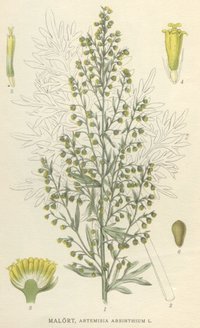Absinth Wormwood
|
|
| Absinth Wormwood | ||||||||||||||
|---|---|---|---|---|---|---|---|---|---|---|---|---|---|---|
| wormwood (Artemisia absinthium) | ||||||||||||||
| Scientific classification | ||||||||||||||
|
Absinth Wormwood (Artemisia absinthium) is a medicinal plant and a type of wormwood, so named because it was traditionally used to cure intestinal worms. It has been used to repel fleas and moths and in brewing to make the liqueur absinthe. It is also used medically as a tonic, stomachic, febrifuge and anthelmintic. It is native to Europe and Siberia and is now widespread in the United States.
| Contents |
Description
A hardy, herbaceous perennial, it can grow to 4 feet tall (1 meter). It is covered in silky silvery-white hairs and many oil-producing glands. Its stems are a silvery-green color, straight, grooved, branched, and covered in leaves.
The leaves are alternate, a greenish-grey color on the upper side, and almost white and silky underneath. The basal leaves measure up to 25 centimetres in length and have long petioles. The cauline leaves (those on the stem) have short petioles and are less divided. The top leaves can even be both simple and sessile (without a petiole). The plant blossoms from July to September. Its flowers are yellow, tubular, and clustered in spherical bent-down heads (composite flowers), which are in turn clustered in leafy and branched panicles.
The plant has a hard rhizome.
Botanical Characteristics
- Reproductive organs:
- Type of inflorescence: cluster of heads
- Sexual division: hermaphrodite
- Type of pollination: anemophilous
- Flowering period: July to September
- Seed:
- Type of fruit: achene
- Seed dissemination: gravity
- Distribution and habitat:
- Habitat type: long-fallow xerophilous land, middle-European
- Area of distribution: Eurasia
Distribution and Habitat
This plant originated in the temperate climates of continental Europe, Asia and North Africa, but it has been naturalized elsewhere. It grows naturally on uncultivated, arid ground, on rocky slopes, and at the edge of footpaths and fields.
Cultivation
The plant can easily be cultivated in low-grade, dry soil. They should be planted under bright exposure in fertile, mid-weight soil. It prefers pedocal soil, rich in nitrogen. It can be propagated by growth or by seeds in nursery beds.
Uses
- In a garden
The plant's characteristic odor can make it useful for making a plant spray against pests. In the practice of companion planting, because of the secretions of its roots, it exerts an inhibiting effect on the growth of surrounding plants, thus weeds. It can be useful to repel larvae worms but it need only be planted on the edge of the area of cultivation.
- As the base for the liquor absinthe and in wine
- Therapeutic uses
Gather the flowering tops in addition to the leaves when the plant is in full bloom. Dry them quickly in the shade or, if by artificial heat, at 95° to 105°F maximum. Be aware that after drying, the herb has the tendency to re-humidify. Its active substances include silica, two bitter elements (absinthine and anabsinthine), thujone, tannic and resinous substances, malic acid, and succinic acid. It can be used therapeutically to remedy insufficient gastric acid, to promote blood circulation in the pelvic regions and biliary excretions, as a disinfectant, and as a vermifuge. To use, infuse one to two teaspoons of the herb per cup of water, drinking one cup two to three times a day. A wine can also be made by macerating the herb. It is also used in powder form, in which case 2 to 3 grams should be used per dose. Its tincture should be used as follows: 10 to 30 drops in half a cup of water, take two to three times per day, 3 minutes before the meal (as a tonic); 20 to 60 drops in a quarter cup of water three time a day (for bile). This plant does contain dangerous active substances. Limited use of this herb is recommended. It should not be used at all by pregnant women.
da:Have-Malurt (Artemisia absinthium) de:Wermutkraut et:Koirohi fr:Absinthe gl:Absintio nl:Absintalsem pl:Bylica piołun fi:Koiruoho sv:Malört

